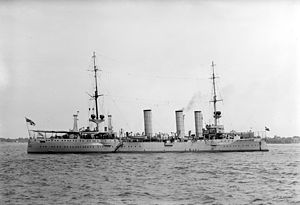SMS Stettin

SMS Stettin in 1912
|
|
| History | |
|---|---|
|
|
|
| Name: | Stettin |
| Namesake: | Stettin |
| Builder: | AG Vulcan, Stettin |
| Laid down: | 1906 |
| Launched: | 7 March 1907 |
| Commissioned: | 29 October 1907 |
| Struck: | 5 November 1919 |
| Fate: | Ceded to Britain 1920, scrapped in 1921–1923 |
| General characteristics | |
| Class and type: | Königsberg-class light cruiser |
| Displacement: |
|
| Length: | 115.3 m (378 ft) |
| Beam: | 13.2 m (43 ft) |
| Draft: | 5.29 m (17.4 ft) |
| Propulsion: | 4 shafts, 2 Parsons steam turbines 13,500 shaft horsepower (10,100 kW) |
| Speed: | 24.1 knots (44.6 km/h; 27.7 mph) |
| Complement: |
|
| Armament: |
|
| Armor: |
|
SMS Stettin ("His Majesty's Ship Stettin") was a Königsberg-class light cruiser of the Kaiserliche Marine. She had three sister ships: Königsberg, Nürnberg, and Stuttgart. Laid down at AG Vulcan Stettin shipyard in 1906, Stettin was launched in March 1907 and commissioned into the High Seas Fleet seven months later in October. Like her sisters, Stettin was armed with a main battery of ten 10.5 cm (4.1 in) guns and a pair of 45 cm (18 in) torpedo tubes, and was capable of a top speed in excess of 25 knots (46 km/h; 29 mph).
In 1912, Stettin joined the battlecruiser Moltke and cruiser Bremen for a goodwill visit to the United States. After the outbreak of World War I, Stettin served in the reconnaissance forces of the German fleet. She saw heavy service for the first three years of the war, including at the Battle of Heligoland Bight in August 1914 and the Battle of Jutland in May – June 1916, along with other smaller operations in the North and Baltic Seas. In 1917, she was withdrawn from frontline service and used as a training ship until the end of the war. In the aftermath of Germany's defeat, Stettin was surrendered to the Allies and broke up for scrap in 1921–1923.
Stettin was ordered under the contract name "Ersatz Wacht" and was laid down at the AG Vulcan shipyard in her namesake city in 1906. She was launched on 7 March 1907, after which fitting-out work commenced. She was commissioned into the High Seas Fleet on 29 October 1907. The ship was 115.3 meters (378 ft) long overall and had a beam of 13.2 m (43 ft) and a draft of 5.29 m (17.4 ft) forward. She displaced 3,814 t (3,754 long tons; 4,204 short tons) at full combat load. Her propulsion system consisted of two 3-cylinder triple expansion engines powered by eleven coal-fired Marine-type boilers. These provided a top speed of 25.2 knots (46.7 km/h; 29.0 mph) and a range of approximately 5,750 nautical miles (10,650 km; 6,620 mi) at 12 knots (22 km/h; 14 mph). Stettin had a crew of 14 officers and 308 enlisted men.
...
Wikipedia
